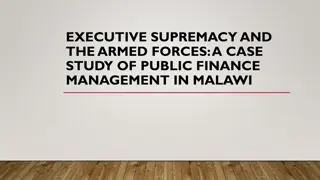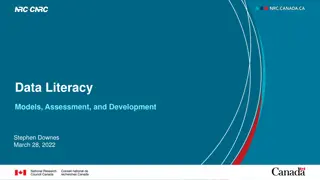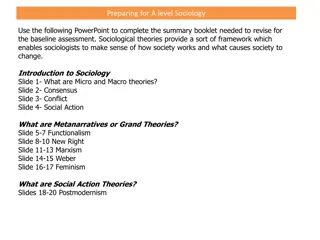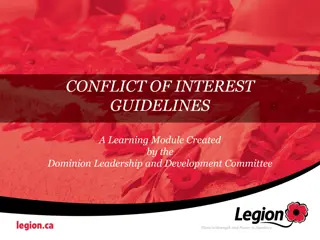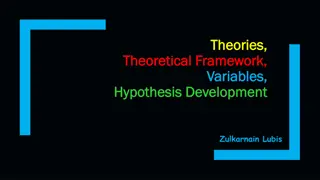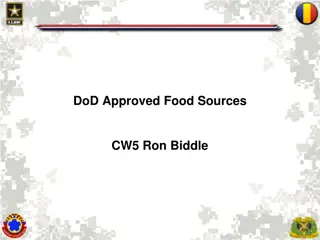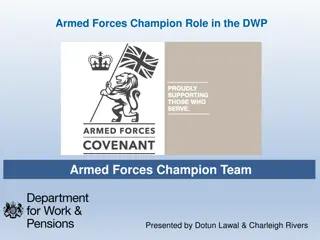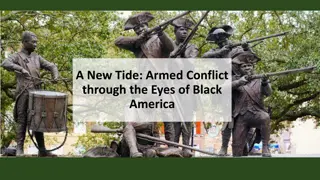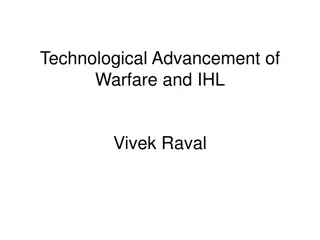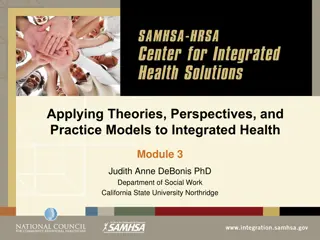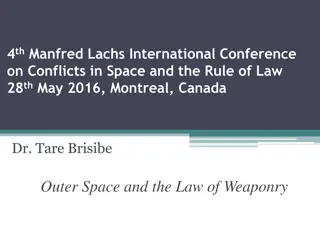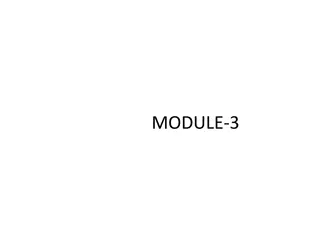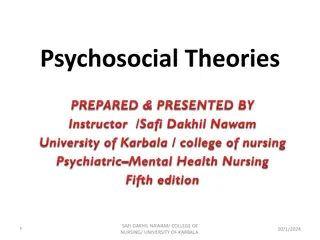Trends, Theories, and Analytical Frameworks in Contemporary Armed Conflicts
This module explores current trends, theories, and analytical frameworks in contemporary armed conflicts, presented by Dr. Pter Kacziba from the Department of Political Science and International Studies at the University of Pcs. The content delves into the complexity of security and peace in an uncertain world, shedding light on the challenges and dynamics of modern conflicts. It also includes a disclaimer to be added to publications supported by the European Commission when authored by external independent bodies.
Download Presentation

Please find below an Image/Link to download the presentation.
The content on the website is provided AS IS for your information and personal use only. It may not be sold, licensed, or shared on other websites without obtaining consent from the author.If you encounter any issues during the download, it is possible that the publisher has removed the file from their server.
You are allowed to download the files provided on this website for personal or commercial use, subject to the condition that they are used lawfully. All files are the property of their respective owners.
The content on the website is provided AS IS for your information and personal use only. It may not be sold, licensed, or shared on other websites without obtaining consent from the author.
E N D
Presentation Transcript
SECURITY AND PEACE IN AN UNCERTAIN WORLD First module: Trends, theories and analytical frameworks 3. Contemporary armed conflicts P ter Kacziba, PhD Department of Political Science and International Studies University of P cs
The following disclaimer shall be added to the inner pages of the publications and studies written by external independent bodies with support from the European Commission: , , , . BG Podpora Evropsk komise p i tvorb t to publikace nep edstavuje souhlas s obsahem, kter odr pouze n zory autor , a Komise nem e b t zodpov dn za jak koliv vyu it informac obsa en ch v t to publikaci. CS Europa-Kommissionens st tte til produktionen af denne publikation udg r ikke en godkendelse af indholdet, som kun afspejler forfatternes egne synspunkter, og Kommissionen kan ikke holdes ansvarlig for den brug, der m tte blive gjort af de deri indeholdte oplysninger. DA Die Unterst tzung der Europ ischen Kommission f r die Erstellung dieser Ver ffentlichung stellt keine Billigung des Inhalts dar, welcher nur die Ansichten der Verfasser wiedergibt, und die Kommission kann nicht f r eine etwaige Verwendung der darin enthaltenen Informationen haftbar gemacht werden. DE , , . EL The European Commission's support for the production of this publication does not constitute an endorsement of the contents, which reflect the views only of the authors, and the Commission cannot be held responsible for any use which may be made of the information contained therein. EN El apoyo de la Comisi n Europea para la producci n de esta publicaci n no constituye una aprobaci n del contenido, el cual refleja nicamente las opiniones de los autores, y la Comisi n no se hace responsable del uso que pueda hacerse de la informaci n contenida en la misma. ES Euroopa Komisjoni toetus k esoleva v ljaande koostamisele ei t henda v ljaandes esitatud sisu kinnitamist. V ljaandes esitatud sisu peegeldab vaid autorite seisukohti. Euroopa Komisjon ei vastuta selles sisalduva teabe kasutamise eest. ET Euroopan komission tuki t m n julkaisun tuottamiseen ei tarkoita sit , ett sis lt , joka kuvastaa pelk st n tekij iden n kemyksi , saa kannatusta, eik komissiota voida saattaa vastuuseen niiden sis lt mien tietojen mahdollisesta k yt st . FI Le soutien de la Commission europ enne la production de cette publication ne constitue pas une approbation du contenu, qui refl te uniquement le point de vue des auteurs, et la Commission ne peut pas tre tenue responsable de toute utilisation qui pourrait tre faite des informations qu elle contient. FR N hionann taca ocht an Choimisi in Eorpaigh do th irgeadh an fhoilseach in seo agus formhuini ar bhair an fhoilseach in, lena l ir tear tuairim na n- dar amh in, agus n f idir freagracht a chur ar an gCoimisi n bhfaisn is at ann. GA as aon s id a d fh adfa a bhaint as an HR Potpora Europske komisije proizvodnji ove publikacije ne predstavlja potporu sadr aju koji odra ava samo stavove autora i Komisija ne mo e biti odgovorna za uporabu sadr anih informacija.
Az Eurpai Bizottsg tmogatsa ezen kiadvny elksztshez nem jelenti a tartalom jvhagyst, amely kizrlag a szerzk ll spontj t t kr zi, valamint a Bizotts g nem tehet felel ss ezen inform ci k b rminem felhaszn l s rt. HU Il sostegno della Commissione europea alla produzione di questa pubblicazione non costituisce un'approvazione del contenuto, che riflette esclusivamente il punto di vista degli autori, e la Commissione non pu essere ritenuta responsabile per l'uso che pu essere fatto delle informazioni ivi contenute. IT Europos Komisijos parama io leidinio rengimui nerei kia pritarimo jo turiniui, kuriame pateikiama autori nuomon , tod l Europos Komisija negali b ti laikoma atsakinga u informacij panaudot iame leidinyje. LT Eiropas Komisijas atbalsts s publik cijas sagatavo anai nav uzskat ms par satura apstiprin jumu, kas atspogu o tikai autoru viedok us, un Komisija nevar b t atbild ga par taj ietvert s inform cijas jebk du izmanto anu. LV L-appo tal-Kummissjoni Ewropea g all-produzzjoni ta din il-pubblikazzjoni ma jikkostitwixxix approvazzjoni tal-kontenut, li jirrifletti biss il-fehmiet tal-awturi, u l-Kummissjoni ma tistax tin amm responsabbli g al kwalunkwe u u li jista jsir mill- informazzjoni li tinsab fiha. MT De steun van de Europese Commissie voor de productie van deze publicatie houdt geen goedkeuring van de inhoud in. De inhoud geeft de standpunten van de auteurs weer en de Commissie kan niet aansprakelijk worden gesteld voor het gebruik dat eventueel wordt gemaakt van de daarin opgenomen informatie. NL PL Wsparcie Komisji Europejskiej dla produkcji tej publikacji nie stanowi poparcia dla tre ci, kt re odzwierciedlaj jedynie pogl dy autor w, a Komisja nie mo e zosta pociagni ta do odpowiedzialno ci za jakiekolwiek wykorzystanie informacji w niej zawartych. O apoio da Comiss o Europeia produ o desta publica o n o constitui um aval do seu conte do, que reflete unicamente o ponto de vista dos autores, e a Comiss o n o pode ser considerada respons vel por eventuais utiliza es que possam ser feitas com as informa es nela contidas. PT RO Sprijinul acordat de Comisia European pentru elaborarea acestei publica ii nu constituie o aprobare a con inutului, care reflect doar opiniile autorilor, iar Comisia nu poate fi tras la r spundere pentru orice utilizare a informa iilor con inute n aceasta. Podpora Eur pskej komisie na v robu tejto publik cie nepredstavuje s hlas s obsahom, ktor odr a len n zory autorov, a Komisia nem e by zodpovedn za pr padn pou itie inform ci , ktor s v nej obsiahnut . SK Podpora Evropske komisije za pripravo te publikacije ne pomeni potrditve vsebine, ki izra a le mnenja avtorjev, in Komisija ne more biti odgovorna za kakr no koli uporabo informacij, ki jih vsebuje. SL Europeiska Kommissionens st d t framst llningen av detta dokument utg r inte ett godk nnande av dess inneh ll, vilket endast terspeglar upphovsm nnens sikter, och Kommissionen kan inte h llas ansvarigt f r n gon anv ndning av informationen i det. SV
Basic concepts and definitions Morton Deutsch: constructive and destructive conflicts. Conflict is a natural part of human creativity and desire for change. The process and outcome of conflict is not necessarily negative Conflict can remain constructive and productive if properly managed and ending with either compromise or positive change. Question 1: Positive examples? E.g. The extension of personal freedom to every human being. Deutsch refers to such examples as constructive conflicts, which have fostered human progress peacefully. However, conflicts do not always remain constructive. Destructive conflicts occur when differing opinions cannot be reconciled and the disagreement escalates into a destructive dispute. Destructive dispute does not necessarily mean armed confrontation; the progress of others can be damaged and hindered without the use of force. Nonetheless, in the most critical situations, destructive conflict may resort to armed violence.
Basic concepts and definitions The main types of destructive conflicts: armed conflicts and wars. But what is the difference between them? 1. Statistical method: According to the Uppsala University s Department of Peace and Conflict Research: "An armed conflict is a contested incompatibility that concerns government and/or territory where the use of armed force between two parties, results in at least 25 battle-related deaths in one calendar year". While war is "a state-based conflict which reaches at least 1000 battle-related deaths in a specific calendar year
Basic concepts and definitions 2. Distinction made by military sciences: - armed conflict is a crisis situation, while war is a wide scale organized and at least two-sided violence; - armed conflict attempts to resolve a conflict of interest, while war aims to defeat the opponent(s); - in armed conflicts only part of the armed forces are involved, while in wars all or majority of them participate.
Basic concepts and definitions What is not war? We should separate War from other types of violence. War is not necessarily considered to be the same as occupation, murder, or genocide because of the reciprocal nature of the violent struggle, and the organized nature of the units involved. War is a form of organized and wide scale mutual direct violence. Carl Clauzewitz, On War: War is the collision of two living forces" and "total nonresistance would be no war at all".
Causes of armed conflicts 1. 2. Dan Smith, The State of War and Peace: Individual decision-makers decide to use force Hans Morgenthau, Politics among Nations: Interstate struggles, power politics, anarcic international environment Paul Collier and Anke Hoeffler, Justice seeking and Loot-Seeking in Civil War: Economic reasons (poverty, lack of resources, low level of GDP or GDI, archaic character of the National Economy, its dependence on external factors). Keith Jaggers and Ted Robert Gurr, Tracking Democracy s Third Wave with the Polity III Data: Social transformations (transit from authoritarianism to democracy, creation of new nation-states. David Horovitz, Ethnic Groups in the Conflict: Ethnic diversity: theory of group rights. Thomas Homer-Dixon, Environment, scarcity and violence: Natural reasons (natural changes, natural catastrophes) Bruce Russet, Grasping the Democratic Peace: Political character of the states involved in wars. The Democracies are not fighting each others. John G. Stoessinger: Why Nations Go to War: Moral reasons: involved parties will claim that morality justifies their fight. John Burton, Conflict Resolution and Prevention: Human needs theory: War can be initiated if the practice of basic human needs are threatened or antagonized. 3. 4. 5. 6. 7. 8. 9.
Types of armed conflicts The typology varies widely depending on the author, organization, region, country, etc. Few examples: 1. International Humanitarian Law: - International armed conflict - Internationalized armed conflict - Non-international conflict 2. Uppsala Conflict Database's typology - Extrastate - Interstate - Intrastate - Internationalized intrastate - (Colonial wars) 3. Ramsbotham, Woodhouse, and Miall s (2016) typology: - Interstate - Non-interstate: revolution/ideology; identity/secession; economic/resource
Other characterizations Symmetric wars: equal strength. Usually involves conventional warfare which is an attempt to reduce an opponent's military capability through open battle. Asymmetric wars: non-equal strength Total war: Wars involving multiple great powers. Total wars include significant destruction and loss of life. Since the end of World War II, total wars have become less frequent. Nuclear war: may be limited Limited war: The objective is not surrender and occupation of enemy territory, but rather to attain limited goals. Hybrid war: mixed warfare. It is an attempt to achieve military victory through acquiescence, capitulation, or clandestine support for one side of an existing conflict. (e.g. terrorism)
Post-Cold War concepts: Traditional wars vs. New wars Kaldor, Mary (2012), New and Old Wars: Organized Violence in a Global Era. Polity Press, Cambridge. Traditional wars: Interstate wars Relatively short period Fights between armies and soldiers Strategic points are the targets Economies transformed to produce war material, but the overall structure of the political, economic or social life is unchanged. New wars: Intrastate wars Some kind of ideological background Last a long time, with periods of fighting punctuated by periods of relative calm. Human costs are high: both combatants and civilians are killed. The whole political, economic and social structure is transformed: Food supplies are interrupted, health systems are damaged, money is diverted from constructive economic development to purchasing armaments. Entire generations may grow up knowing only a state of war.
Post-Cold War concepts: Transnational Conflicts Ramsbotham, O., Woodhouse, T., & Miall, H. (2016): Contemporary Conflict Resolution. Polity Press, Cambridge: Polity Press.
Multilevel analysis of transnational conflicts Task for the remaining time of the lesson: Identify possible answers using the example of the Russian-Ukrainian war.
Bibliography Smith, Dan (ed.) (1997) The State of War and Peace Atlas. PRIO, London. Ramsbotham, Oliver Woodhouse, Tom Miall, Hugh (2016): Contemporary Conflict Resolution. Polity Press, Cambridge: Polity Press, pp. 110-143. Kaldor, Mary (2012), New and Old Wars: Organized Violence in a Global Era. Polity Press, Cambridge.
Thank you for your attention!




